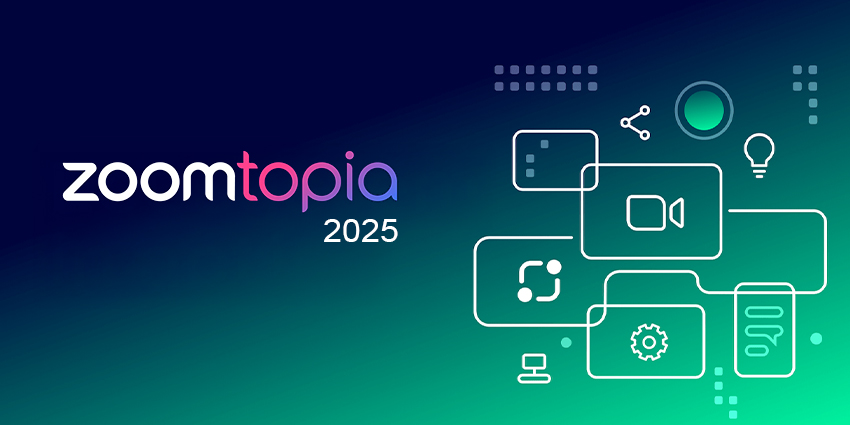Zoomtopia 2025 kicked off with some big announcements, many of which centered on the main innovation: AI Companion 3.0.
Marking what the company calls “a new era of productivity, intelligent collaboration, and connection,” the update centers on AI Companion’s evolution from an assistant to a proactive work partner that can understand user context, priorities, and goals to deliver personalized assistance across multiple surfaces and integrations.
Beyond the core AI Companion features, Zoom announced substantial updates to its workplace suite and Zoom Virtual Agent.
This entailed a general AI uplift to extend the current capabilities offered by these suites, opening up new use cases and vertical applications.
This move highlights Zoom’s role in the frontline, healthcare, and education sectors, some of which it has long been targeting. However, are the updates here enough to truly move the dial and make it the platform of choice in these sectors?
Addressing the Vertical Communications Gap
The UC industry has long struggled with adoption challenges outside office-based environments.
While knowledge workers have embraced platforms like Zoom for daily collaboration, specialized industries have remained largely untouched by the digital communication revolution.
Yet the number of frontline workers outpaces deskbound workers by four to one. This represents a huge market, prompting companies like Zoom to tailor their offerings more specifically for these verticals.
Zoom’s latest announcement at Zoomtopia 2025 introduced innovations targeted at healthcare, education, and frontline workers.
For healthcare, the new Zoom Virtual Agent for Healthcare features industry-specific AI agent templates, custom medical dictionaries, and Electronic Health Records (EHR) integrations designed for clinical and administrative workflows such as patient intake, scheduling, insurance verification, and post-visit follow-ups.
In practice, a clinic could use an AI agent template to automatically verify insurance coverage against its database, schedule appointments based on provider availability and patient preferences, and deliver personalized post-visit instructions in line with treatment protocols—all while maintaining HIPAA compliance and logging interactions in the EHR system.
This represents a significant departure from generic virtual assistants toward purpose-built healthcare automation.
In education, Zoom Video Management emerges as a centralized platform for institutions to manage lecture recordings, training, and projects across departments.
The solution includes AI transcription and translation capabilities optimized for educational content, alongside seamless integrations with major Learning Management Systems such as Canvas, Brightspace, Moodle, and Blackboard.
This allows entire semesters to be searchable, with AI-powered terminology recognition enabling richer context within lectures, as well as translated outputs for international students. Its ability to integrate with Canvas also means lecture content can be directly embedded into course modules.
For frontline workers, Zoom announced an expanded hardware certification program, initially partnering with Jabra to offer certified Bluetooth headsets, with nurses and retail clerks highlighted as key users.
A hospital nurse managing multiple patients could, for example, use a certified headset to get real-time updates from colleagues while keeping their hands free for patient care.
These updates focusing on the frontline sectors have come as a welcome announcement for many.
“I like how Zoom is bringing AI to specific industries. Healthcare, frontline workers, government, and education all now have solutions tailored to their needs,”
Zeus Kerravala, Founder and Principal Analyst of ZK Research, notes.
“Typically, uptake of communications beyond knowledge workers has been low, as generic tools aren’t valuable to this audience.”
These vertical-specific enhancements represent a strategic shift that could significantly expand Zoom’s utility in these markets.
By incorporating industry-specific vocabularies and templates, workflow integrations, and compliance frameworks, the platform becomes more than just another meeting tool—it becomes part of critical daily operations.
Yet the question remains whether these incremental improvements, layered onto Zoom’s existing horizontal platform, are enough to make it indispensable.
Zoom’s Existing Vertical Positioning
The introduction of Zoom Virtual Agent for Healthcare, expected in January 2026, represents its most comprehensive healthcare-specific offering yet, tackling persistent challenges around patient communication and administrative automation.
This builds on years of gradual market penetration. In 2017, Zoom launched Zoom for Telehealth, including integration with EHR provider Epic. This allowed cloud-based video, audio, and content sharing, a “virtual waiting room,” and easy embedding into clinical workflows.
The pandemic truly accelerated demand. From 2020–2022, many non-emergency consultations moved online. Having already built healthcare functionality, Zoom became one of the preferred platforms. In 2021, it rebranded the service as Zoom for Healthcare, extending features to include integration with diagnostic cameras and digital stethoscopes.
Capabilities have since been expanded through partnerships such as with Suki, an AI-powered voice assistant that helps streamline administrative telehealth tasks. Bit by bit, Zoom has made its healthcare tools more tailored to vertical needs.
The question now is whether Zoom has reached a tipping point to become the go-to UC platform for major industries like healthcare.
Strategic Gaps in Vertical Execution
Although UCaaS providers often tout their efforts to specialize for verticals, it is not always their main priority.
“UCaaS providers love to talk about verticals. These are typically more about GTM and marketing than actual product changes,”
Dave Michels, Lead Analyst at TalkingPointz, says.
As with Zoomtopia 2025, vertical updates often ride on the coattails of broader platform announcements. But because this year’s central theme was AI, the vertical updates could be more impactful.
“Zoom is now leading with AI, so its vertical push is more significant. Healthcare, for example, has a very specialized vocabulary that confuses most AI systems. Zoom is building a very strong vertical focus with its AI and integrations that will give it a major advantage in healthcare,” Michels explains.
An AI-first approach helps overcome past limitations, where generic systems failed to understand industry-specific language and workflows.
By investing in custom AI templates and integrating with industry platforms like EHRs, LMSs, and frontline systems, Zoom reduces implementation friction and improves the odds of lasting adoption.
Still, competition looms. In healthcare, smaller but more specialized vendors have purpose-built communication tools deeply tied to medical processes. Zoom’s horizontal approach—with added vertical integrations—must show it can meet these same needs while still offering the broader benefits of a cross-industry platform.
AI advancements could prove to be the deciding factor.
AI-Powered Vertical Strategy Shows Promise
The launch of AI Companion 3.0, paired with vertical-focused AI tools, represents a more transformative path than simply adding superficial industry features.
Healthcare templates could help safely automate medical documentation and integrate with decision-making processes. Education features could categorize and cross-reference course material, generate accessible summaries, and suggest curriculum improvements based on outcomes data.
The real advantage may be in Zoom’s AI foundation, which positions it for ongoing improvements in each vertical.
Looking ahead, success will depend on delivering measurable, industry-specific results: reduced administrative burden for healthcare providers, better engagement for education, and greater efficiency in frontline environments.
The technology foundation is promising, but success in verticals will depend on solving real challenges beyond simply offering more communication tools.







